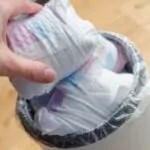Ultimate Checklist: What To Carry In Diaper Bag?

Embarking on any adventure with your baby, whether it’s a quick trip to the grocery store or a day out in the park, can feel like preparing for a major expedition. This is where the humble diaper bag comes into play, not just as an accessory, but as a crucial part of your baby-care arsenal. For new parents, the art of packing a diaper bag can be as daunting as the outing itself. Why? Because babies, delightful as they are, are predictably unpredictable.
The importance of a well-packed diaper bag cannot be overstated. It’s your lifeline when you’re away from the comfort of home, a portable supply kit that can handle everything from diaper disasters to hunger cries, sudden fevers, or just the need for a comforting toy. Packing the right items in your diaper bag means being prepared for a wide array of situations, ensuring that both you and your baby remain calm and happy throughout your outdoor adventures.
In this blog, we’ll guide you through the ultimate checklist for what to carry in diaper bag. This guide is designed not just to help you pack but to give you the peace of mind that comes from knowing you’re well-prepared. So, buckle up and get ready to transform your diaper bag into a treasure trove of baby essentials!
1 Understanding the Essentials: Navigating Through the Basics
When it comes to packing your diaper bag, it’s all about striking the perfect balance between being prepared and avoiding overpacking. The key lies in understanding and navigating through the basics effectively. Let’s dive into what constitutes the essentials.
Diapers: Types and Quantity

Number of Diapers Needed Based on Outing Duration
The golden rule of thumb is to pack one diaper for every two hours you plan to be out, plus a couple of extra for good measure. This estimate ensures that you’re covered for unexpected delays or emergencies. For a quick trip, maybe three to four diapers will suffice, but for an all-day outing, you might need around six to eight. Remember, it’s always better to have a few extras than to be caught short.
Comparison of Cloth vs. Disposable Diapers for Outings
The choice between cloth and disposable diapers for outings hinges on personal preference and your baby’s comfort. Disposable diapers are convenient, less bulky, and don’t require dealing with soiled diapers until you’re back home. However, if you’re environmentally conscious and have a good system for dealing with dirty cloth diapers (like wet bags), cloth diapers can be a viable option. They may require more space and a bit more planning, but they are equally effective.
Wipes and Changing Supplies
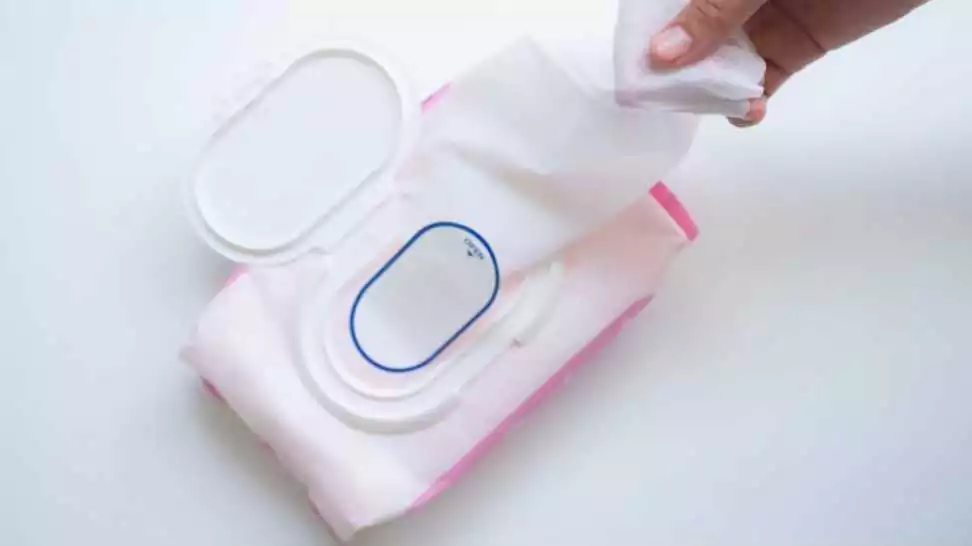
Importance of Baby Wipes and Their Various Uses
Baby wipes are indispensable in a diaper bag. They’re not just for diaper changes; they come in handy for cleaning hands and faces, wiping down surfaces, or even as a quick refresh for yourself. Opt for hypoallergenic and alcohol-free wipes to ensure they are gentle on your baby’s skin.
Other Changing Supplies
- Portable Changing Pad: A must-have for clean, hygienic diaper changes on the go. Look for one that’s easy to clean and fold.
- Diaper Rash Cream: A small tube can be a lifesaver for preventing or treating diaper rash, especially during longer outings.
- Plastic or Biodegradable Bags: For disposing of diapers or carrying soiled clothes.
- Extra Set of Baby Clothes: Accidents happen, and having a change of clothes is essential.
- Hand Sanitizer: For cleaning your hands after diaper changes, especially when you don’t have access to soap and water.
2 Feeding Time: Nutrition on the Go
When you’re out and about with your baby, ensuring they are well-fed and happy is crucial. This part of your diaper bag is dedicated to meeting their nutritional needs, regardless of whether they’re still on a liquid diet or have moved on to solids. Let’s explore how to pack efficiently for feeding time.
Bottles and Formula/Breast Milk

Packing Bottles, Formula, and Breast Milk: Storage and Temperature Considerations
- Bottles: Pack as many bottles as you’ll need for the duration of the outing, plus one extra as a backup. Pre-filling the bottles with the right amount of water can save time if you’re formula feeding.
- Formula: For formula, consider using a formula dispenser with pre-measured amounts to make mixing on the go easy and mess-free. If you prefer ready-to-feed formula, ensure it’s packed securely to avoid leaks.
- Breast Milk: If you’re carrying breast milk, use insulated bags with ice packs to maintain the appropriate temperature. Breast milk can be kept at room temperature for a few hours, but it’s best to use it as soon as possible after warming.
Snacks and Solid Food (for Older Babies)
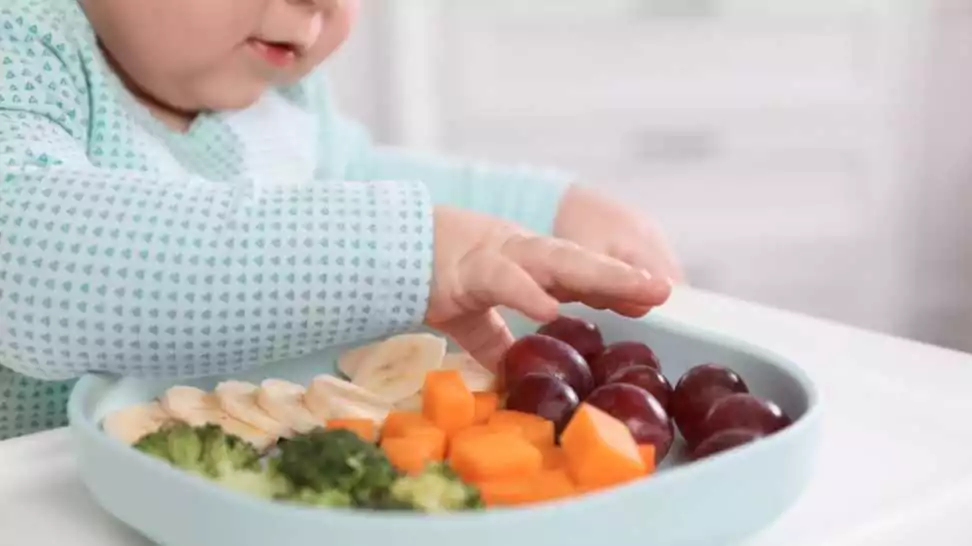
Ideas for Easy-to-Carry, Mess-Free Snacks
- Fruits and Veggies: Pack bite-sized pieces of soft fruits like bananas or steamed carrots in small containers.
- Puffs and Crackers: These are great for older babies who can munch on solid foods. They’re not only easy to handle but also dissolve quickly, minimising choking hazards.
- Yoghurt or Applesauce Pouches: Convenient for on-the-go feeding and usually a hit with little ones.
- Utensils and Containers for Feeding
- Spill-Proof Cups: Essential for water or juice, especially for toddlers.
- Small Spoons: Soft-tipped spoons are gentle on your baby’s gums and small enough to fit in their mouths comfortably.
- Bib: A waterproof or disposable bib can make clean-up easier.
- Containers: Opt for leak-proof containers to keep snacks fresh and prevent messes in your diaper bag.
3 Clothing and Comfort
A crucial aspect of packing your diaper bag is preparing for the inevitable spills, accidents, and the ever-changing moods of your little one. This section focuses on clothing essentials and comfort items that can turn a potentially stressful situation into a calm one.
Spare Outfits
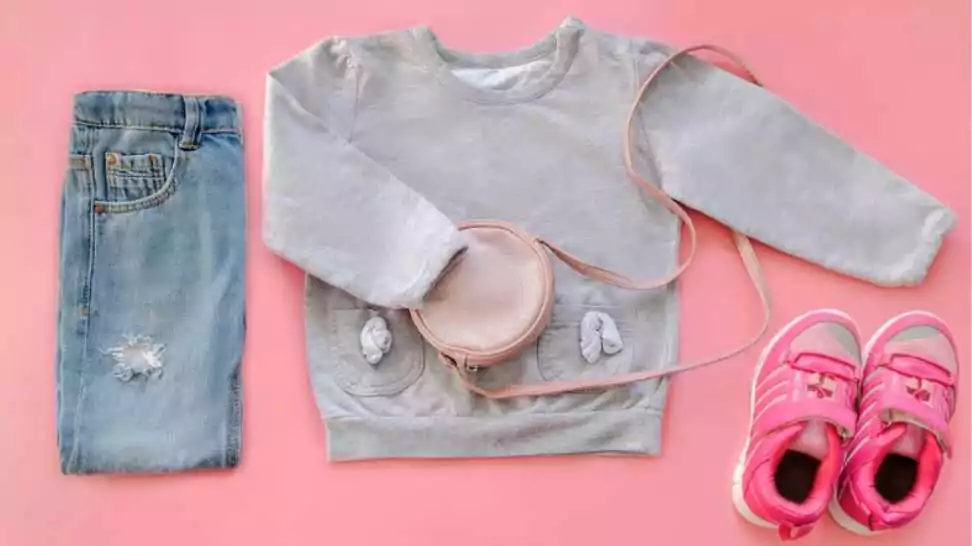
Preparing for Spills and Accidents: How Many to Pack
As a general rule, pack at least one or two spare outfits, depending on the length of your outing. Accidents like diaper leaks, spit-ups, or food spills are common, and a fresh outfit can make your baby more comfortable.
Include socks and a hat, as these small items are often the first to get misplaced or dirty.
Seasonal Clothing Considerations
- Warm Months: Pack light layers that can be added or removed easily. Think of breathable fabrics like cotton.
- Cold Months: Always include an extra sweater or jacket, along with warm hats and mittens. Layering is key to ensuring your baby stays warm without overheating.
- Rainy Weather: A waterproof cover can be a lifesaver for sudden showers.
- Sun Protection: In sunny weather, include a hat with a brim and lightweight long sleeves for sun protection.
Comfort Items
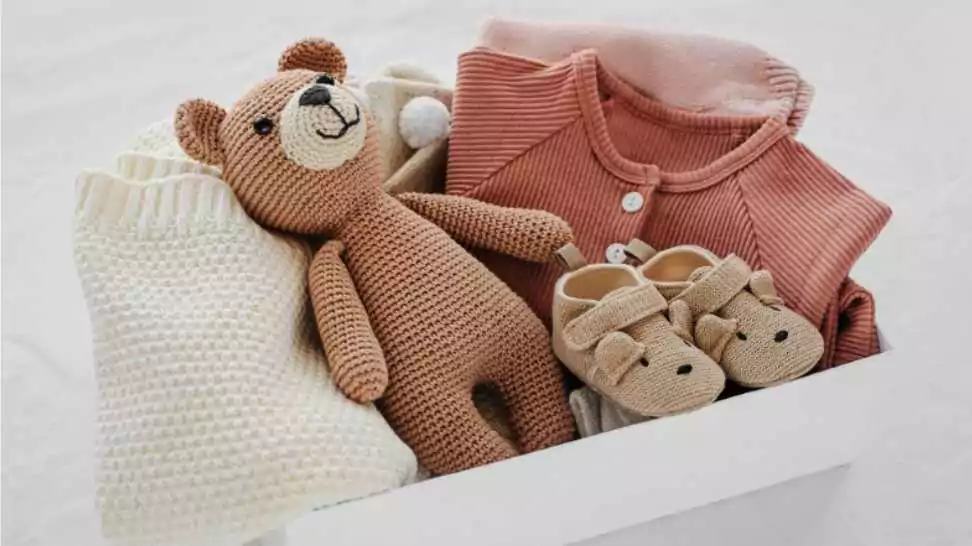
Importance of Pacifiers, Teething Toys, and Favourite Blankets or Stuffed Animals
- Pacifiers: If your baby uses a pacifier, pack a couple of extras in a clean, sealed container. Pacifiers can easily get lost or dirty, and a spare can be a quick fix.
- Teething Toys: For babies going through the teething phase, a teething toy can provide relief and distraction. Choose one that’s easy to clean and safe for your baby.
- Blankets and Stuffed Animals: A familiar blanket or a favourite stuffed animal can be a source of comfort and security for your baby, especially in unfamiliar environments. This can be particularly helpful for naps or when your baby is feeling overwhelmed.
4 Health and Hygiene
Maintaining your baby’s health and hygiene is a top priority, especially when you’re on the go. In this section, we’ll explore the essentials for keeping your baby healthy and addressing minor health concerns during your outings.
Hand Sanitizer and Surface Cleaners

Keeping Germs at Bay While Out and About
- Hand sanitiser is your best friend when it comes to maintaining hygiene. Look for a baby-friendly hand sanitiser that’s alcohol-free and gentle on your baby’s skin.
- Baby wipes can also be used to clean your hands and surfaces when soap and water are not readily available. They are versatile and serve a dual purpose.
First Aid Kit
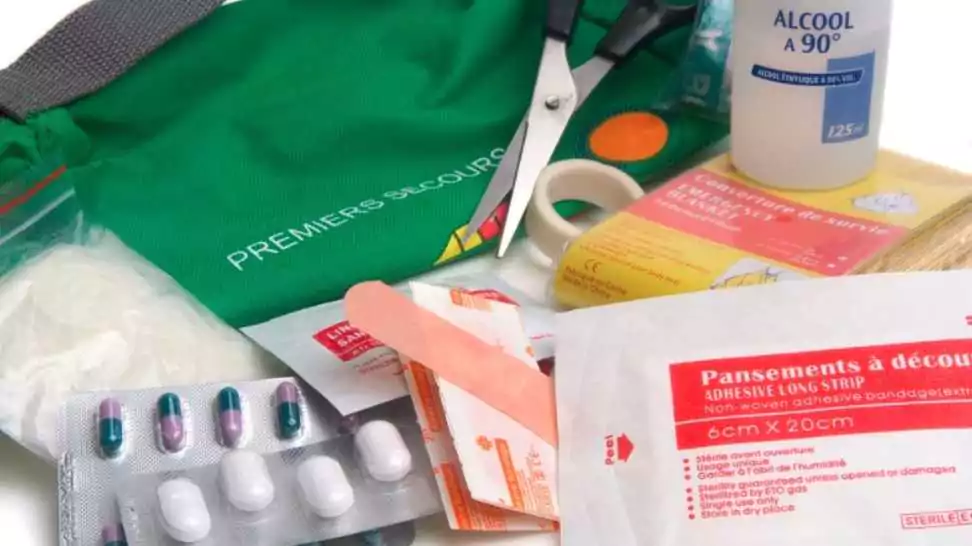
Essentials for a Baby First Aid Kit
- Band-Aids: Small cuts and scrapes can happen unexpectedly, so having a few kid-sized band-aids in your diaper bag is a smart move.
- Thermometer: A digital thermometer can help you monitor your baby’s temperature in case they start feeling unwell during your outing.
- Saline Nasal Drops: These can come in handy if your baby has a stuffy nose.
- Baby Pain Reliever: Consult with your paediatrician and, if recommended, carry an appropriate baby pain reliever.
- Tweezers: Useful for removing splinters or foreign objects.
- Emergency Contact Information: Have a card with your baby’s doctor’s contact information and any allergies or medical conditions, just in case.
5 For the Parent: Don’t Forget About You!
When packing a diaper bag, it’s crucial to remember that it’s not just for baby essentials. Parents, too, need to be prepared for any outing. Here’s a guide to ensure you don’t overlook your necessities.
Personal Items
- Wallet, Keys, Phone: These are your essentials. Ensure your wallet contains your ID, any necessary cards, and a bit of cash. Your keys are your ticket back home, and your phone keeps you connected.
- Other Personal Items: Think about what you might need during your time out. This could include lip balm, hand sanitiser, a water bottle, or a snack. Remember, keeping yourself comfortable is as important as taking care of your baby.
Emergency Contacts and Information
- Medical Information: It’s wise to carry a small card or note in your bag with essential medical information. This includes any allergies, medical conditions, and your primary care doctor’s contact details.
- Emergency Contacts: Apart from having these in your phone, having a physical copy of emergency contacts is invaluable, especially if your phone runs out of battery or gets lost. Include contacts for family members, your child’s paediatrician, and a reliable neighbour or friend.
6 Organising Your Diaper Bag: Tips and Tricks
Efficiently organising your diaper bag can make outings with your little one much smoother. Here’s how to choose the right bag and pack it for maximum efficiency.
Choosing the Right Bag
- Size Matters: Look for a bag that’s spacious enough to hold all your essentials without being too bulky. Consider the length of your trip and the number of items you’ll need.
- Compartments are Key: Multiple compartments and pockets can be a lifesaver. They help in segregating items like diapers, wipes, feeding bottles, and your personal items, making everything easily accessible.
- Ease of Cleaning: Babies can be messy, so choose a bag made from a material that’s easy to clean. Water-resistant fabrics are ideal as they can be wiped down quickly in case of spills.
Packing Efficiently
- Prioritise Accessibility: Place the items you’ll need most often (like diapers and wipes) in the most accessible spots. Outer pockets are great for items you need to grab quickly.
- Maximise Storage: Roll clothes and use packing cubes to save space. Utilise every nook and cranny of your bag, but avoid overstuffing as it can make items harder to find.
- Regular Reassessment: Periodically reassess what you carry. As your baby grows, their needs change, and so should the contents of your diaper bag.
7 Adapting to Your Baby’s Changing Needs
As your baby grows and develops, their needs change, and so should the contents of your diaper bag. Here’s how to adapt to these changes and also make seasonal adjustments for a well-prepped outing.
Adjusting the Contents as Your Baby Grows
- Infants: For the youngest ones, your bag should include plenty of diapers, wipes, a changing pad, burp cloths, a spare outfit, and feeding essentials like bottles or breastfeeding supplies. Don’t forget pacifiers and a favourite blanket for comfort.
- Crawlers: As your baby becomes more active, include items like a change of clothes for messier explorations, safe toys to keep them entertained, and snacks for energy. Baby-proofing essentials like outlet covers can be handy for visits.
- Toddlers: Toddlers require fewer diapers but more snacks and activities. Pack interactive toys, books, and colouring supplies. Include a Sippy cup, and don’t forget the first aid kit for little adventurers who might have minor scrapes.
Seasonal Adjustments
- Summer Outings: For summer, include sunscreen, a sun hat, extra water, and lightweight clothing. Consider a small fan or cooling towel to keep your baby comfortable in the heat.
- Winter Excursions: In winter, pack extra layers for your child, including hats, mittens, and warm socks. Include a thermos with warm water or milk, and consider a warm blanket or footmuff for strollers.
8 Wrapping Up
In summary, the significance of a well-prepared diaper bag cannot be overstated. It’s not just about carrying supplies; it’s about ensuring peace of mind, preparedness, and the ability to respond to your baby’s needs at a moment’s notice. A thoughtfully packed diaper bag is a silent companion that supports you through the unpredictability of parenting on the go.
We encourage all parents to see their diaper bag as a personal toolkit. Customise it to fit the unique needs of your family. What works for one parent might not work for another, and as your child grows, the contents of your bag will evolve. Embrace this change as part of the journey.
Community Q&A
About This Article
This article has been viewed 93 times.


